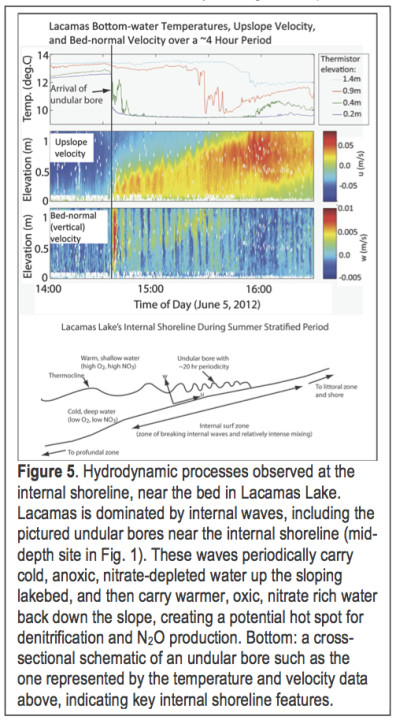Lakes and reservoirs provide us with important stores of freshwater, and with popular sites for recreation. Many lakes and reservoirs are also polluted, and play an important role in global biogeochemical cycles. Through an NSF-funded interdisciplinary project, combining expertise in hydrodynamics (Environmental Hydrodynamics Laboratory) and biogeochemistry (Global Change and Watershed Biogeochemistry Lab), we are studying the processing of pollutants in lakes, with particular emphasis on Nitrogen and methane pollution. Recently, in collaboration with Sally MacIntyre, we also conducted a pilot experiment in a tundra pond in Alaska, to examine heat transport and mixing process likely associated with global warming.
The lakes we have studied display a fascinating range of hydrodynamic behaviour, from daily-period development and destruction of stratification, to newly-discovered vertically propagating lakewide internal waves. The internal waves cause dramatic fluctuations in near-bed stratification and mixing rates, which are likely important to lakebed removal of nitrate pollution. Internal waves sometimes form undular bores or break as they propagate up the sloping lakebed (measurements of an undular bore are shown below). You can read more about these waves, and nearbed stratification/mixing, in two powerpoint presentations, one for a general audience, and another (two files) aimed at physical oceanographers. A more detailed description of progress to-date is provided in these four papers:
2. Upslope internal wave Stokes drift, and compensating downslope Eulerian mean currents, observed above a lakebed, published in the Journal of Physical Oceanography (examines how waves transport water laterally through the lake, in a manner reminiscent of the Stokes drift that is balanced by undertow on a beach).
3. Turbulent production in an internal wave bottom boundary layer maintained by a vertically propagating seiche, published in the Journal of Geophysical Research (Oceans) [examines the energy balance relating supply of internal wave energy to the lakebed and loss of wave energy to turbulence].
4. Chemical mixing in the bottom boundary layer of a eutrophic reservoir: The effects of internal seiching on Nitrgen dynamics (examines the interactions between waves and near-bed biogeochemistry, in press for the journal `Limnology and Oceanography’).
Ph.D. student Jeff Nielsen is now finding that simple models, based on closures previously developed by adopting Monin-Obukhov theory to shear-induced estuarine stratification, predict the observed thickening of near-bed mixed layers over a sloping lakebed, allowing us to predict rates of irreversible boundary layer mixing (ocean sciences presentation). With Danielle Wain and Lee Bryant, whose visit to Washington was funded by the British Royal Society, Jeff has also quantified Oxygen fluxes at the sediment-water interface. With Dan Kelly and Clark Richards, supported by a LOREX fellowship, Jeff is also examining upslope-propagating internal wave features found in lakebed boundary layers that at first sight resemble the internal solitons and boluses often found in the coastal ocean. This work is continuing in collaboration with the Global Change and Watershed Biogeochemistry Lab.
